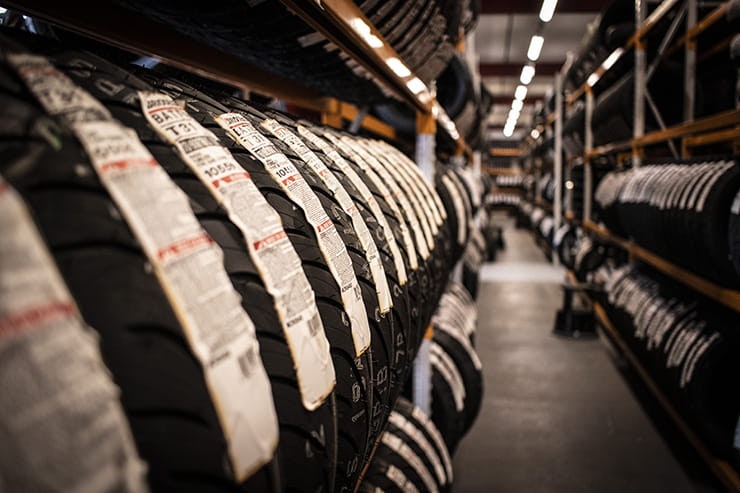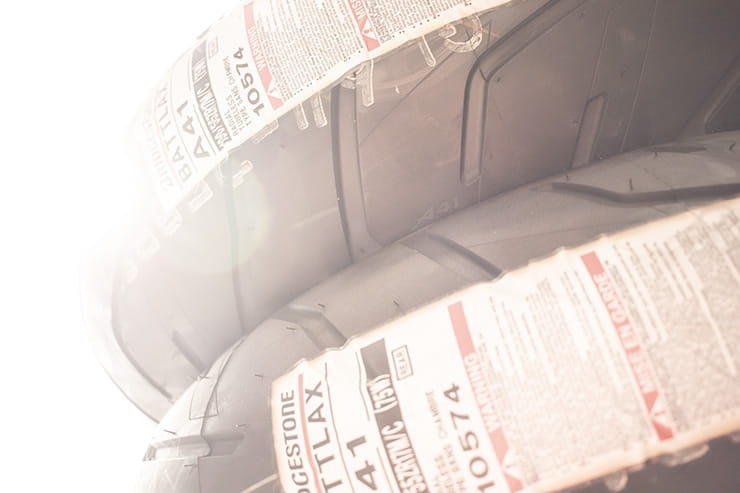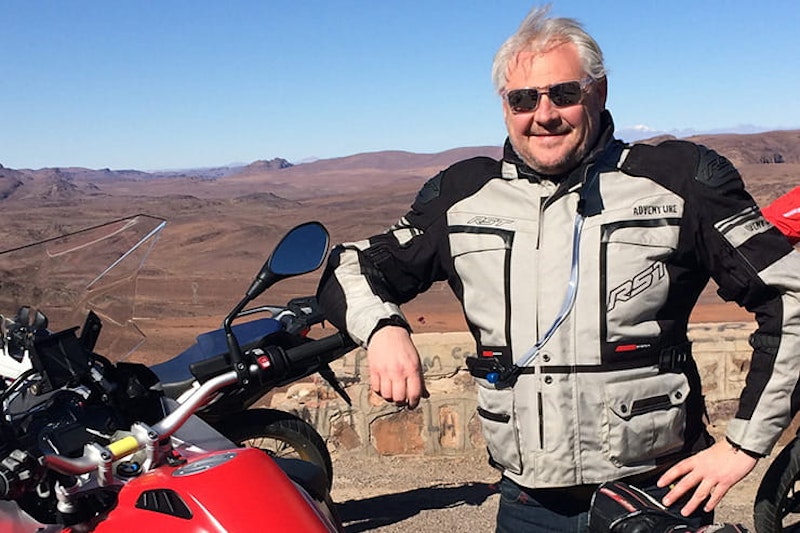What’s the best tyre for my custom or cruiser bike? How to choose motorcycle rubber…
By John Milbank
Consumer Editor of Bennetts BikeSocial
10.05.2019
Cruiser and custom bikes have a wide variety of tyre choices available, but whether you have a Harley-Davidson or a Triumph Rocket III, a fully custom café racer or a Ducati Scrambler, choosing the right tyre is easier when you understand the technology that goes into them.
Most tyre reviews will vary depending on the person riding, and big comparison tests typically look at grip on track, so we spoke to Gary Hartshorne, Senior Motorcycle Product Manager for Bridgestone North Europe, to find out how you can make the right choices for yourself…
Gary’s a passionate biker, riding all kinds of bikes more than 25,000 miles every year
What’s the best tyre for my custom, cruiser, scrambler or café racer?
The size and style of your bike will be a big influence on the best rubber. These are what Gary recommends – we’ll get into why next…
Does it matter how heavy or powerful my bike is?
Yes, absolutely. All tyres are made to meet European Tyre and Rim Technical Organisation (ETRTO) specifications – at any given axle weight, a certain load rating of tyre (and a specific pressure) will be required. Every tyre’s carcass is designed to work within the parameters given to ensure they’re safe for the maximum total load the bike, its luggage and passenger will put on the front and rear axles. Tyres have a pair of numbers that refer to the maximum load that a single tyre can safely support, and a letter that denotes the speed:
Motorcycle tyre load index in kg
Motorcycle tyre speed ratings in mph
* At reduced loading
You mustn’t use a tyre that’s got a lower speed rating than the bike requires, though snow tyres – which are lower – are the exception. The load ratings are also a legal requirement, but there’s nothing saying you have to use the tyre brand or model recommended by the bike manufacturer.
Your bike might use cross-ply, bias-belt, radial or zero-degree radials – none are an outdated technology, but each has a carcass that deforms differently, so it’s important to use the construction of tyre intended for your bike, or it could significantly affect the handling as the suspension is designed to work with a certain type of tyre.
You can mix cross-plies and radials, but only a certain way – you can fit a cross-ply front and a radial rear, but it’s illegal to do it the other way around. Basically, you can only put the more flexible tyre on the front, which gives you various options, but the safest answer is to take the advice of the tyre manufacturer.
Cross-ply and radial mixing options
How do I know what tyres to fit to my custom bike?
If you have a completely custom machine, choosing the most suitable – and safest – tyres might be confusing, but ultimately it just comes back to the axle weight and the top speed.
If you have a custom bike, you can call a tyre manufacturer – Gary tells us that Bridgestone’s technical team are always happy to help – and ask for recommendations; as long as you have the individual axle weights for the front and rear of the bike, and the maximum speed, you’ll be able to easily find out all the rubber that would be compatible.
What if I want knobbly tyres?
As long as the load and speed ratings are compatible (or the rubber is rated as a snow tyre), you can fit road-legal knobblies to anything you like. But there will be compromises – while they’ll likely grip great in loose mud, wet road performance probably won’t be as good as a sport-touring tyre for instance. You’ll also find that knobbly tyres wear out more quickly, as the movement within the blocks generates more heat.
How does the tread pattern affect my tyres?
Tread patterns are designed to look good, but the grooves are also carefully developed to pick up water and throw it out of the way, leaving a drier patch of tarmac for the next ‘slick’ patch of tyre to grip. It’s also worth knowing that tyres are designed as pairs, so in the wet, the rear will be running over the tarmac that the front has just worked on.
A mismatched set of tyres – like a sport-touring front and a sports rear – could see the rear struggle as it’s having to deal with the water it’s shifting, plus that displaced by the front.
Gary tells us that some tyre pairs now have what appears to be a reverse tread on the front, relative to the rear – this is to throw the displaced water away from the inside of a turn, rather than into it, reducing the amount of water the rear tyre has to shift as it runs over the tarmac the front’s just covered.
What pressures should I run my tyres at?
Tyre pressures aren’t arbitrary – they’re based purely on the specifications set out by the ETRTO, so your bike’s axle weights are what dictate it. On a standard machine, you might find a sticker on the bike (maybe on the swingarm), or in the handbook. Don’t go by random numbers you find on forums – use the specified pressures as they’re based on science, not guesswork.
You should NOT drop tyre pressures in the wet, as not only will the tyre often deform in such a way that the contact patch is reduced, the tread grooves will close up and become less efficient.
If you’re riding a bike like this on the track, you’re also unlikely to need to change the pressures, unless you’re up in the intermediate or fast groups on a custom that’s a true sports bike at heart.
How long should my custom or cruiser tyres last?
How many years or miles you get out of a front or rear tyre will depend not just on its compound (and whether it has a harder-wearing compound in the centre of the tread area), but how you ride, and the pressures you’re running.
Incorrect pressures will lead to damage to the carcass and excessive temperature, while if you’re heavy on the throttle or the brakes, your tyres will wear much more quickly than if you’re a smooth rider. Tyre manufacturers will give a guide as to how long you should get, so if you’re seeing much less, check your pressures and your riding style.
How do I scrub my tyres in?
Bridgestone doesn’t use a release agent in the construction of its tyres – the moulds are extremely smooth so there’s no need. In fact, some other manufacturers have also moved away from using anything that potentially leaves your new rubber feeling greasy, but that doesn’t mean you don’t need to take care when you’ve got new tyres on.
The industry standard is to recommend 200 miles of careful riding – gently and incrementally increasing lean, while being smooth and progressive with the throttle and brakes. This is to not only rough the surface of the rubber up, but also to allow the plies in the tyre to settle into each other. Also, on high-powered bikes, it’s possible for the tyre to slip on the fresh ‘soap’ that fitters use if you accelerate too hard, leaving the wheel out of balance.
How should I store my bike if it’s not being ridden
If you’re not riding your bike much, and it’s not on paddock stands that keep the wheels off the ground, you need to check your tyre pressures every week (all tyres lose pressure over time), and you should rotate the wheels 90°, to move the contact patch.
As your tyres deflate gradually, excessive force will be put on the tyre’s carcass, which will damage it. And we’re not talking about enough air loss that the tyres will be visibly flat.
You could inflate the tyres to the maximum shown on the sidewall, but you must leave a note on the bike’s tank to remind you to drop the pressures back down to the recommended level before you ride, and you’ll still need to check and rotate them. You should also put some carpet under the tyres, so the rubber isn’t damaged by a cold floor in harsh winters.
Ideally, store your bike on paddock stands, or an Abba Sky Lift, to keep it off the ground.
If you have the wheels out of the bike, or loose tyres, store them out of sunlight and away from freezing conditions – on their side under the bed or in the loft is ideal.
What if I don’t like the OE tyres that came with my bike?
During development, motorcycle manufacturers don’t test their bikes with every set of tyres available – some brands might use just one, others might use several. From this data will come the bike maker’s recommended fitment, but all tyres are made to conform to European Tyre and Rim Technical Organisation (ETRTO) specifications, so within the axle weights, maximum speed and the sizes, there will be other options that can safely be recommended by other brands.
Some top-of-the-range motorcycles, like the BMW S1000RR, will come with top-spec tyres, but others might have rubber that’s been designed specifically to be sold with the bike when new. These could look the same as similarly-named tyres, but might have one or two extra letters at the end if their name.
Just one example of this is a pair of sports tyres that might be single-compound for the bike that they come with (like the Bridgestone RS10G on the Yamaha R1), but multi-compound when bought after-market (the Bridgestone RS10). A single compound tyre is of course less costly to produce, so a bike manufacturer might specify that as part of its requirements when developing the machine, but they could last fewer miles than the after-market versions.
No bike manufacturer can tell you that you must use a specific brand of tyre – what matters is that you stick to the correct sizes and load/speed ratings, and that you run them at the correct pressures. Each tyre manufacturer will offer a list of recommended fitments, then you can choose which best suits your riding style.
Bridgestone’s choice.
Bridgestone’s Gary Hartshorne explains how to choose the best bike tyres
What about other brands?
We worked with Bridgestone to explain how to choose the best tyres for your custom or cruiser bike– once you’ve got your head around the technology, you’ll more easily buy the right rubber for your motorcycle. We also asked the other most popular manufacturers for their recommendations. Of course, these are a general recommendation, and not specific to a particular bike, so always check the fitment for your motorcycle…
Bridgestone recommended custom/cruiser tyres
Big cruiser: Battlecruise H50
Café racer: Battlax RS10, S22, Adventurecross Scrambler AX41S or even BT45, depending on what it is
Scrambler: Battlax Adventurecross Scrambler AX41 S
Anlas recommended custom/cruiser tyres
Big cruiser: Not available
Café racer: Not available
Scrambler: Capra X
Avon recommended custom/cruiser tyres
Big cruiser: Cobra Chrome
Café racer: Roadrider
Scrambler: Trekrider
Continental recommended custom/cruiser tyres
Big cruiser: Conti Tour
Café racer: Classic Attack
Scrambler: TKC80
Dunlop recommended custom/cruiser tyres
Big cruiser: American Elite
Café racer: Sportmax Mutant
Scrambler: Sportmax Mutant or Trailsmart Max
Maxxis recommended custom/cruiser tyres
Big cruiser: Classic M6011F/R and M6011 /Whitewall
Café racer: Maxxis Supermaxx ST / MA-PS – Maxxis Sport
Scrambler: Maxxis MAPD / CM509 Dakar
Metzeler recommended custom/cruiser tyres
Big cruiser: ME888 Marathon Ultra
Café racer: Roadtec 01 Xply
Scrambler: Karoo Street
Michelin recommended custom/cruiser tyres
Big cruiser: Commander II and Scorcher for Harley Davidsons
Café racer: Pilot Activ if using old wheel sizes, Power RS on modern rim sizes
Scrambler: Anakee Adventure
“The named tyres are in general one of the most appropriate tyres for the stated type of bike and use. These generalisations are not Michelin recommendations. The law, the specific bike and the intended use are all factors that must be considered when determining the correct choice of tyre. Always seek expert advice if in doubt.”
Pirelli recommended custom/cruiser tyres
Big cruiser: Night Dragon
Café racer: Phantom Sportscomp
Scrambler: MT 60 RS


